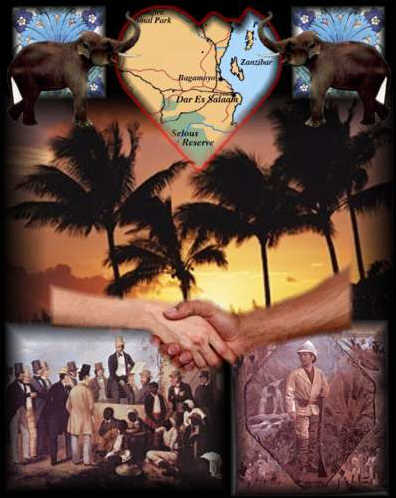
HISTORY

BAGAMOYO
AND
ITS
HISTORY
The
Livingstone
Club’s
name
is
connected
to
the
famous
Scottish
explorer
who
left
a
deep
memory
in
Bagamoyo.
Dr.
Livingstone
was
also
a
great
missionary
and
his
humanitarian
activity
led
to
the
abolition
of
slavery.
Bagamoyo
is
now
a
picturesque
and
quiet
village
of
fishers
but
in
the
past
it
was
a
famous
outpost
in
slave
trade
and
an
arriving
point
of
caravans
carrying
ivory.
Ancient
buildings
give
evidence
of
the
turmoiling
past
events
involving
different
civilisations
trying
to
extend
their
power
in
this
area:
the
Shirazi
Arabs
from
Persia,
the
Portuguese,
the
Arabs
from
the
Oman
Sultanate
in
Zanzibar,
the
Germans
and
the
English.
Bagamoyo
is
located
at
70
km
north
of
Dar
Es
Salaam,
on
the
river
Ruvu
delta.
It
is
a
tiny
coast
town
gathered
around
a
harbour
and
a
market
of
typical
Arabian
character.
Its
name
derives
from
the
Kiswahili
word
“bwagamoyo”
which
means
“leave
your
heart”.
It
was
the
non-return
point
of
the
slaves
travelling
from
the
Tanganika
Lake,
here
they
were
embarked
on
boats
and
sent
to
Zanzibar
to
be
sold.
The
fortress
where
the
slaves
were
imprisoned
dates
back
to
1832.
Today
it
is
a
police
station
and
it
still
keeps
the
underground
tunnel
which
led
to
the
embarking
place.
This
harbour
was
also
the
goal
of
the
first
missionaries
who
brought
with
them
their
fight
against
slavery.
The
Catholic
mission,
at
2
km
from
the
town
centre,
is
the
oldest
in
East
Africa
and
it
is
the
seat
of
a
unique
museum.
It
exhibits
objects
dating
back
to
the
times
of
slavery
trade
and
documents
relevant
to
the
first
European
explorers:
Burton,
Spike,
Stanley
and
Livingstone
who
lived
here
and
here
organised
their
expeditions.
In
the19th
century,
for
four
years
Bagamoyo
was
the
chief
town
of
the
German
East
Africa
Company
and
Protectorate
and
many
buildings
give
evidence
of
it.
The
history
of
the
town
begins
in
the
14th
century
when
the
eastern
coast
of
Africa
was
colonised
by
Arabs
and
Shirazi
coming
from
the
Persian
Gulf.
Five
km
south
of
Bagamoyo
we
find
Kaole:
it
is
now
a
tiny
unimportant
village
but
between
the
13th
and
the
19th
century
it
controlled
the
northern
coast
of
the
country.
Among
the
coconut
trees
and
the
luxuriant
vegetation,
it
is
possible
to
visit
the
ruins
of
the
ancient
town
with
its
various
houses,
the
two
mosques
of
the
14th
century
and
pilaster
tombs.
Bagamoyo
develops
along
the
seaside
in
a
labyrinth
of
narrow
and
tortuous
streets,
small
mosques,
bars
and
white
German
colonial
buildings.
Many
of
them
were
abandoned
but
the
ones
along
the
shore
are
little
by
little
being
restructured.
The
beach
is
splendid
and
desert
but
near
the
old
German
customs
construction
where
the
fishers
meet
to
trade,
it
is
possible
to
buy
lobsters
and
fresh
fishes.
Bagamoyo offers its visitors a tasteful cocktail of ... sun - sea - culture -safari.